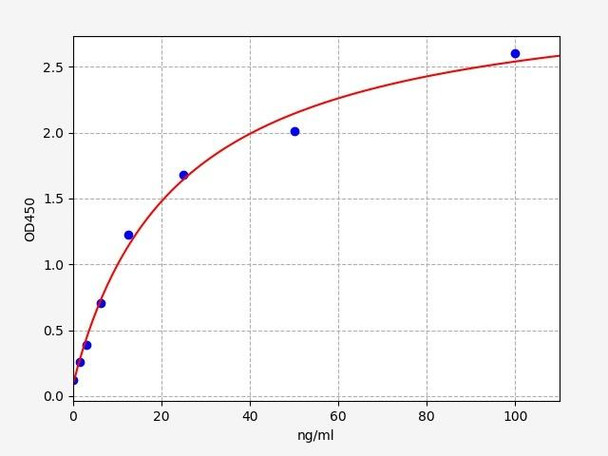Human PDK4 / Pyruvate Dehydrogenase Kinase Isozyme 4 ELISA Kit
- SKU:
- HUFI02722
- Product Type:
- ELISA Kit
- Size:
- 96 Assays
- Uniprot:
- Q16654
- Sensitivity:
- 0.938ng/ml
- Range:
- 1.563-100ng/ml
- ELISA Type:
- Sandwich ELISA, Double Antibody
- Synonyms:
- PDK4, PDHK4, Pyruvate Dehydrogenase Kinase Isozyme 4
- Reactivity:
- Human
Description
| Product Name: | Human PDK4 / Pyruvate Dehydrogenase Kinase Isozyme 4 ELISA Kit |
| Product Code: | HUFI02722 |
| Size: | 96 Assays |
| Alias: | PDK4, PDHK4, Pyruvate Dehydrogenase Kinase Isozyme 4 |
| Detection method: | Sandwich ELISA, Double Antibody |
| Application: | This immunoassay kit allows for the in vitro quantitative determination of Human PDK4 concentrations in serum plasma and other biological fluids. |
| Sensitivity: | 0.938ng/ml |
| Range: | 1.563-100ng/ml |
| Storage: | 4°C for 6 months |
| Note: | For Research Use Only |
| Recovery: | Matrices listed below were spiked with certain level of Human PDK4 and the recovery rates were calculated by comparing the measured value to the expected amount of Human PDK4 in samples. | ||||||||||||||||
| |||||||||||||||||
| Linearity: | The linearity of the kit was assayed by testing samples spiked with appropriate concentration of Human PDK4 and their serial dilutions. The results were demonstrated by the percentage of calculated concentration to the expected. | ||||||||||||||||
| |||||||||||||||||
| CV(%): | Intra-Assay: CV<8% Inter-Assay: CV<10% |
| Component | Quantity | Storage |
| ELISA Microplate (Dismountable) | 8×12 strips | 4°C for 6 months |
| Lyophilized Standard | 2 | 4°C/-20°C |
| Sample/Standard Dilution Buffer | 20ml | 4°C |
| Biotin-labeled Antibody(Concentrated) | 120ul | 4°C (Protect from light) |
| Antibody Dilution Buffer | 10ml | 4°C |
| HRP-Streptavidin Conjugate(SABC) | 120ul | 4°C (Protect from light) |
| SABC Dilution Buffer | 10ml | 4°C |
| TMB Substrate | 10ml | 4°C (Protect from light) |
| Stop Solution | 10ml | 4°C |
| Wash Buffer(25X) | 30ml | 4°C |
| Plate Sealer | 5 | - |
Other materials and equipment required:
- Microplate reader with 450 nm wavelength filter
- Multichannel Pipette, Pipette, microcentrifuge tubes and disposable pipette tips
- Incubator
- Deionized or distilled water
- Absorbent paper
- Buffer resevoir
| Uniprot | Q16654 |
| UniProt Protein Function: | PDHK4: an ubiquitously expressed, atypical protein kinase associated with the mitochondrial matrix. The PDHKs play crucial roles in switching metabolic flux from oxidative phosphorylation towards glycolysis. PDHK4 is abundant in heart, skeletal muscle, kidney, and pancreatic islets. Contains a HATPase_c catalytic domain, found in several ATP-binding proteins including protein histidine kinases (PHKs), PHDKs, DNA gyrase B, topoisomerases, heat shock proteins, and DNA mismatch repair proteins. PDHK regulates glucose oxidation through inhibitory phosphorylation of the E1 alpha subunit of the mitochondrial pyruvate dehydrogenase complex (PDHC) at any one of 3 inhibitory serine residues. Inhibitory sites 1, 2, and 3 correspond to S293, S300, and S232 in human PDHA1, respectively. Four PDHK isoenzymes have been described, each with different site specificity: all four phosphorylate sites 1 and 2 but at different rates; for site 1 PDHK2 >PDHK4 >PDHK1 >PDHK3; for site 2, PDHK3> PDHK4 > PDHK2 > PDHK1. Only PDHK1 phosphorylates site 3. PDHKs are recruited to the PDHC by binding to a lipoyl group covalently attached to the inner lipoyl domain of the E2 component. PDHA1 deficiency is the most common enzyme defect in patients with primary lactic acidosis. Suppression of PDH by PDHK inhibits the conversion of pyruvate to acetyl-CoA, attenuates mitochondrial respiration, and may contribute to the increased lactate production observed in many tumors. The PDH pathway is repressed in a majority of non-small cell lung carcinomas. Inhibited by AZD7545, dichloroacetate (DCA), and radicicol. Radicicol inhibits kinase activity by binding directly to the ATP-binding pocket of PDHK, similar to HSP90 from the same ATPase/kinase superfamily. |
| UniProt Protein Details: | Protein type:Kinase, protein; Mitochondrial; EC 2.7.11.2; Protein kinase, atypical; ATYPICAL group; PDHK family Chromosomal Location of Human Ortholog: 7q21.3 Cellular Component: mitochondrion; mitochondrial matrix; mitochondrial inner membrane Molecular Function:pyruvate dehydrogenase (acetyl-transferring) kinase activity; ATP binding; protein kinase activity Biological Process: response to starvation; cellular metabolic process; regulation of bone resorption; regulation of fatty acid biosynthetic process; regulation of fatty acid oxidation; insulin receptor signaling pathway; regulation of pH; glucose metabolic process; regulation of acetyl-CoA biosynthetic process from pyruvate; pyruvate metabolic process; cellular response to starvation; glucose homeostasis; protein amino acid phosphorylation |
| NCBI Summary: | This gene is a member of the PDK/BCKDK protein kinase family and encodes a mitochondrial protein with a histidine kinase domain. This protein is located in the matrix of the mitrochondria and inhibits the pyruvate dehydrogenase complex by phosphorylating one of its subunits, thereby contributing to the regulation of glucose metabolism. Expression of this gene is regulated by glucocorticoids, retinoic acid and insulin. [provided by RefSeq, Jul 2008] |
| UniProt Code: | Q16654 |
| NCBI GenInfo Identifier: | 3183120 |
| NCBI Gene ID: | 5166 |
| NCBI Accession: | Q16654.1 |
| UniProt Related Accession: | Q16654 |
| Molecular Weight: | 411 |
| NCBI Full Name: | [Pyruvate dehydrogenase (acetyl-transferring)] kinase isozyme 4, mitochondrial |
| NCBI Synonym Full Names: | pyruvate dehydrogenase kinase, isozyme 4 |
| NCBI Official Symbol: | PDK4Â Â |
| NCBI Protein Information: | pyruvate dehydrogenase kinase, isozyme 4; pyruvate dehydrogenase kinase, isoenzyme 4; pyruvate dehydrogenase, lipoamide, kinase isozyme 4, mitochondrial; [Pyruvate dehydrogenase [lipoamide]] kinase isozyme 4, mitochondrial; [Pyruvate dehydrogenase (acetyl-transferring)] kinase isozyme 4, mitochondrial |
| UniProt Protein Name: | [Pyruvate dehydrogenase (acetyl-transferring)] kinase isozyme 4, mitochondrial |
| UniProt Synonym Protein Names: | Pyruvate dehydrogenase kinase isoform 4 |
| UniProt Gene Name: | PDK4Â Â |
| UniProt Entry Name: | PDK4_HUMAN |
*Note: Protocols are specific to each batch/lot. For the correct instructions please follow the protocol included in your kit.
Before adding to wells, equilibrate the SABC working solution and TMB substrate for at least 30 min at 37°C. When diluting samples and reagents, they must be mixed completely and evenly. It is recommended to plot a standard curve for each test.
| Step | Protocol |
| 1. | Set standard, test sample and control (zero) wells on the pre-coated plate respectively, and then, record their positions. It is recommended to measure each standard and sample in duplicate. Wash plate 2 times before adding standard, sample and control (zero) wells! |
| 2. | Aliquot 0.1ml standard solutions into the standard wells. |
| 3. | Add 0.1 ml of Sample / Standard dilution buffer into the control (zero) well. |
| 4. | Add 0.1 ml of properly diluted sample ( Human serum, plasma, tissue homogenates and other biological fluids.) into test sample wells. |
| 5. | Seal the plate with a cover and incubate at 37 °C for 90 min. |
| 6. | Remove the cover and discard the plate content, clap the plate on the absorbent filter papers or other absorbent material. Do NOT let the wells completely dry at any time. Wash plate X2. |
| 7. | Add 0.1 ml of Biotin- detection antibody working solution into the above wells (standard, test sample & zero wells). Add the solution at the bottom of each well without touching the side wall. |
| 8. | Seal the plate with a cover and incubate at 37°C for 60 min. |
| 9. | Remove the cover, and wash plate 3 times with Wash buffer. Let wash buffer rest in wells for 1 min between each wash. |
| 10. | Add 0.1 ml of SABC working solution into each well, cover the plate and incubate at 37°C for 30 min. |
| 11. | Remove the cover and wash plate 5 times with Wash buffer, and each time let the wash buffer stay in the wells for 1-2 min. |
| 12. | Add 90 µl of TMB substrate into each well, cover the plate and incubate at 37°C in dark within 10-20 min. (Note: This incubation time is for reference use only, the optimal time should be determined by end user.) And the shades of blue can be seen in the first 3-4 wells (with most concentrated standard solutions), the other wells show no obvious color. |
| 13. | Add 50 µl of Stop solution into each well and mix thoroughly. The color changes into yellow immediately. |
| 14. | Read the O.D. absorbance at 450 nm in a microplate reader immediately after adding the stop solution. |
When carrying out an ELISA assay it is important to prepare your samples in order to achieve the best possible results. Below we have a list of procedures for the preparation of samples for different sample types.
| Sample Type | Protocol |
| Serum | If using serum separator tubes, allow samples to clot for 30 minutes at room temperature. Centrifuge for 10 minutes at 1,000x g. Collect the serum fraction and assay promptly or aliquot and store the samples at -80°C. Avoid multiple freeze-thaw cycles. If serum separator tubes are not being used, allow samples to clot overnight at 2-8°C. Centrifuge for 10 minutes at 1,000x g. Remove serum and assay promptly or aliquot and store the samples at -80°C. Avoid multiple freeze-thaw cycles. |
| Plasma | Collect plasma using EDTA or heparin as an anticoagulant. Centrifuge samples at 4°C for 15 mins at 1000 × g within 30 mins of collection. Collect the plasma fraction and assay promptly or aliquot and store the samples at -80°C. Avoid multiple freeze-thaw cycles. Note: Over haemolysed samples are not suitable for use with this kit. |
| Urine & Cerebrospinal Fluid | Collect the urine (mid-stream) in a sterile container, centrifuge for 20 mins at 2000-3000 rpm. Remove supernatant and assay immediately. If any precipitation is detected, repeat the centrifugation step. A similar protocol can be used for cerebrospinal fluid. |
| Cell culture supernatant | Collect the cell culture media by pipette, followed by centrifugation at 4°C for 20 mins at 1500 rpm. Collect the clear supernatant and assay immediately. |
| Cell lysates | Solubilize cells in lysis buffer and allow to sit on ice for 30 minutes. Centrifuge tubes at 14,000 x g for 5 minutes to remove insoluble material. Aliquot the supernatant into a new tube and discard the remaining whole cell extract. Quantify total protein concentration using a total protein assay. Assay immediately or aliquot and store at ≤ -20 °C. |
| Tissue homogenates | The preparation of tissue homogenates will vary depending upon tissue type. Rinse tissue with 1X PBS to remove excess blood & homogenize in 20ml of 1X PBS (including protease inhibitors) and store overnight at ≤ -20°C. Two freeze-thaw cycles are required to break the cell membranes. To further disrupt the cell membranes you can sonicate the samples. Centrifuge homogenates for 5 mins at 5000xg. Remove the supernatant and assay immediately or aliquot and store at -20°C or -80°C. |
| Tissue lysates | Rinse tissue with PBS, cut into 1-2 mm pieces, and homogenize with a tissue homogenizer in PBS. Add an equal volume of RIPA buffer containing protease inhibitors and lyse tissues at room temperature for 30 minutes with gentle agitation. Centrifuge to remove debris. Quantify total protein concentration using a total protein assay. Assay immediately or aliquot and store at ≤ -20 °C. |
| Breast Milk | Collect milk samples and centrifuge at 10,000 x g for 60 min at 4°C. Aliquot the supernatant and assay. For long term use, store samples at -80°C. Minimize freeze/thaw cycles. |


![Human [Pyruvate dehydrogenase [lipoamide]] kinase isozyme 1, mitochondrial (PDK1) ELISA Kit Human [Pyruvate dehydrogenase [lipoamide]] kinase isozyme 1, mitochondrial (PDK1) ELISA Kit](https://cdn11.bigcommerce.com/s-39x6lpnvxv/images/stencil/590x590/products/113173/111357/human-pyruvate-dehydrogenase-lipoamide-kinase-isozyme-1-mitochondrial-pdk1-elisa-kit__36445__37757.1647949396.jpg?c=1)
![Mouse [Pyruvate dehydrogenase [lipoamide]] kinase isozyme 1, mitochondrial (Pdk1) ELISA Kit Mouse [Pyruvate dehydrogenase [lipoamide]] kinase isozyme 1, mitochondrial (Pdk1) ELISA Kit](https://cdn11.bigcommerce.com/s-39x6lpnvxv/images/stencil/590x590/products/116801/114985/mouse-pyruvate-dehydrogenase-lipoamide-kinase-isozyme-1-mitochondrial-pdk1-elisa-kit__69977__48953.1647950161.jpg?c=1)
![Rat [Pyruvate dehydrogenase [lipoamide]] kinase isozyme 1, mitochondrial (Pdk1) ELISA Kit Rat [Pyruvate dehydrogenase [lipoamide]] kinase isozyme 1, mitochondrial (Pdk1) ELISA Kit](https://cdn11.bigcommerce.com/s-39x6lpnvxv/images/stencil/590x590/products/118815/116998/rat-pyruvate-dehydrogenase-lipoamide-kinase-isozyme-1-mitochondrial-pdk1-elisa-kit__80942__42715.1647950629.jpg?c=1)




